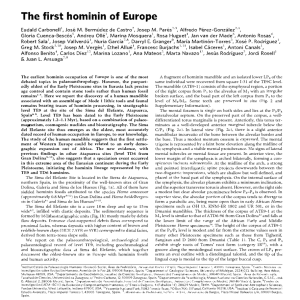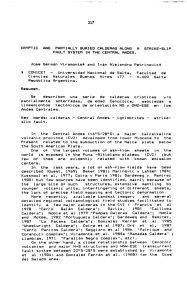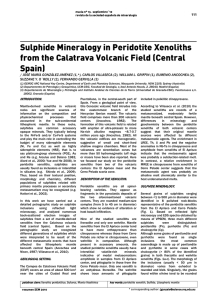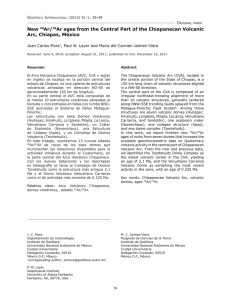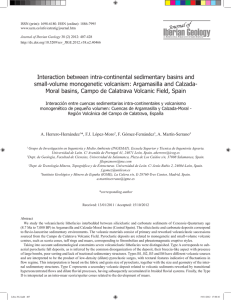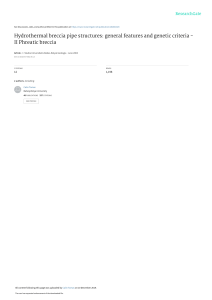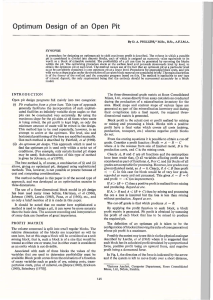La Sima - Universidad de Castilla
Anuncio
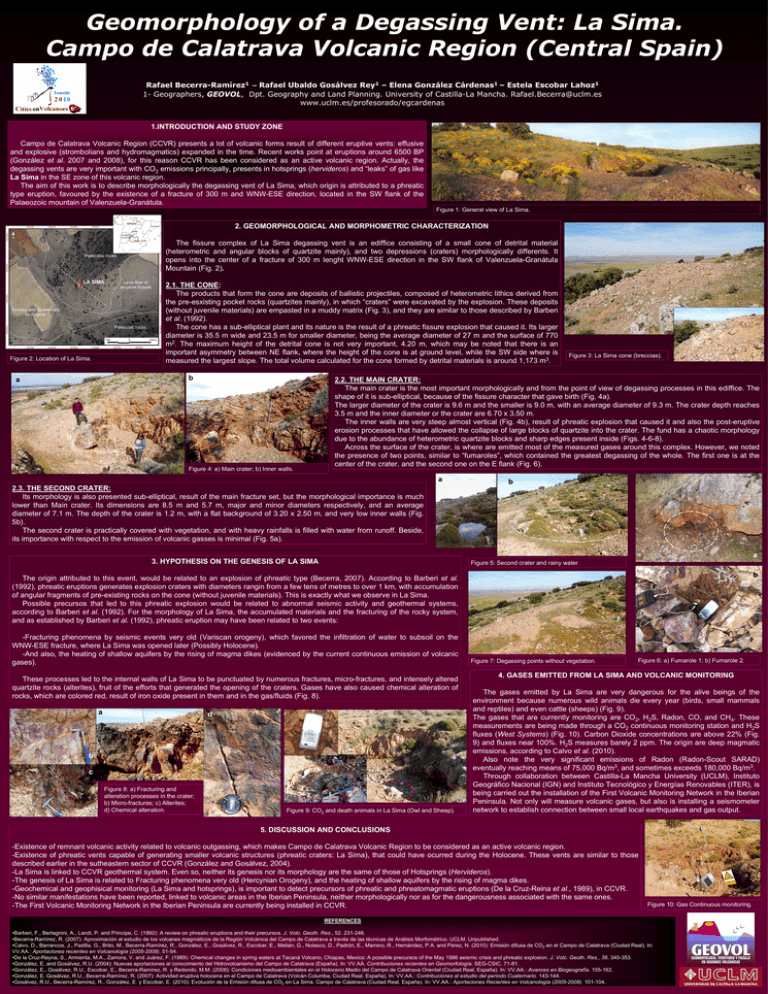
Geomorphology of a Degassing Vent: La Sima. Campo de Calatrava Volcanic Region (Central Spain) Rafael Becerra-Ramírez1 – Rafael Ubaldo Gosálvez Rey1 – Elena González Cárdenas1 – Estela Escobar Lahoz1 1- Geographers, GEOVOL, Dpt. Geography and Land Planning. University of Castilla-La Mancha. [email protected] www.uclm.es/profesorado/egcardenas 1.INTRODUCTION AND STUDY ZONE Campo de Calatrava Volcanic Region (CCVR) presents a lot of volcanic forms result of different eruptive vents: effusive and explosive (strombolians and hydromagmatics) expanded in the time. Recent works point at eruptions around 6500 BP (González et al. 2007 and 2008), for this reason CCVR has been considered as an active volcanic region. Actually, the degassing vents are very important with CO2 emissions principally, presents in hotsprings (hervideros) and “leaks” of gas like La Sima in the SE zone of this volcanic region. The aim of this work is to describe morphologically the degassing vent of La Sima, which origin is attributed to a phreatic type eruption, favoured by the existence of a fracture of 300 m and WNW-ESE direction, located in the SW flank of the Palaeozoic mountain of Valenzuela-Granátula. Figure 1: General view of La Sima. 2. GEOMORPHOLOGICAL AND MORPHOMETRIC CHARACTERIZATION The fissure complex of La Sima degassing vent is an ediffice consisting of a small cone of detrital material (heterometric and angular blocks of quartzite mainly), and two depressions (craters) morphologically differents. It opens into the center of a fracture of 300 m lenght WNW-ESE direction in the SW flank of Valenzuela-Granátula Mountain (Fig. 2). 2.1. THE CONE: The products that form the cone are deposits of ballistic projectiles, composed of heterometric lithics derived from the pre-esxisting pocket rocks (quartzites mainly), in which “craters” were excavated by the explosion. These deposits (without juvenile materials) are empasted in a muddy matrix (Fig. 3), and they are similar to those described by Barberi et al. (1992). The cone has a sub-elliptical plant and its nature is the result of a phreatic fissure explosion that caused it. Its larger diameter is 35.5 m wide and 23.5 m for smaller diameter, being the average diameter of 27 m and the surface of 770 m2. The maximum height of the detrital cone is not very important, 4.20 m, which may be noted that there is an important asymmetry between NE flank, where the height of the cone is at ground level, while the SW side where is measured the largest slope. The total volume calculated for the cone formed by detrital materials is around 1,173 m3. Figure 2: Location of La Sima. b a Figure 4: a) Main crater; b) Inner walls. Figure 3: La Sima cone (breccias). 2.2. THE MAIN CRATER: The main crater is the most important morphologically and from the point of view of degassing processes in this ediffice. The shape of it is sub-elliptical, because of the fissure character that gave birth (Fig. 4a). The larger diameter of the crater is 9.6 m and the smaller is 9.0 m, with an average diameter of 9.3 m. The crater depth reaches 3.5 m and the inner diameter or the crater are 6.70 x 3.50 m. The inner walls are very steep almost vertical (Fig. 4b), result of phreatic explosion that caused it and also the post-eruptive erosion processes that have allowed the collapse of large blocks of quartzite into the crater. The fund has a chaotic morphology due to the abundance of heterometric quartzite blocks and sharp edges present inside (Figs. 4-6-8). Across the surface of the crater, is where are emitted most of the measured gases around this complex. However, we noted the presence of two points, similar to “fumaroles”, which contained the greatest degassing of the whole. The first one is at the center of the crater, and the second one on the E flank (Fig. 6). a b 2.3. THE SECOND CRATER: Its morphology is also presented sub-elliptical, result of the main fracture set, but the morphological importance is much lower than Main crater. Its dimensions are 8.5 m and 5.7 m, major and minor diameters respectively, and an average diameter of 7.1 m. The depth of the crater is 1.2 m, with a flat background of 3.20 x 2.50 m, and very low inner walls (Fig. 5b). The second crater is practically covered with vegetation, and with heavy rainfalls is filled with water from runoff. Beside, its importance with respect to the emission of volcanic gasses is minimal (Fig. 5a). a 3. HYPOTHESIS ON THE GENESIS OF LA SIMA Figure 5: Second crater and rainy water. b The origin attributed to this event, would be related to an explosion of phreatic type (Becerra, 2007). According to Barberi et al. (1992), phreatic eruptions generates explosion craters with diameters rangin from a few tens of metres to over 1 km, with accumulation of angular fragments of pre-existing rocks on the cone (without juvenile materials). This is exactly what we observe in La Sima. Possible precursos that led to this phreatic explosion would be related to abnormal seismic activity and geothermal systems, according to Barberi et al. (1992). For the morphology of La Sima, the accumulated materials and the fracturing of the rocky system, and as established by Barberi et al. (1992), phreatic eruption may have been related to two events: -Fracturing phenomena by seismic events very old (Variscan orogeny), which favored the infiltration of water to subsoil on the WNW-ESE fracture, where La Sima was opened later (Possibly Holocene). -And also, the heating of shallow aquifers by the rising of magma dikes (evidenced by the current continuous emission of volcanic gases). These processes led to the internal walls of La Sima to be punctuated by numerous fractures, micro-fractures, and intensely altered quartzite rocks (alterites), fruit of the efforts that generated the opening of the craters. Gases have also caused chemical alteration of rocks, which are colored red, result of iron oxide present in them and in the gas/fluids (Fig. 8). a d b c Figure 8: a) Fracturing and alteration processes in the crater; b) Micro-fractures; c) Alterites; d) Chemical alteration. Figure 9: CO2 and death animals in La Sima (Owl and Sheep). Figure 7: Degassing points without vegetation. Figure 6: a) Fumarole 1; b) Fumarole 2. 4. GASES EMITTED FROM LA SIMA AND VOLCANIC MONITORING The gases emitted by La Sima are very dangerous for the alive beings of the environment because numerous wild animals die every year (birds, small mammals and reptiles) and even cattle (sheeps) (Fig. 9). The gases that are currently monitoring are CO2, H2S, Radon, CO, and CH4. These measurements are being made through a CO2 continuous monitoring station and H2S fluxes (West Systems) (Fig. 10). Carbon Dioxide concentrations are above 22% (Fig. 9) and fluxes near 100%. H2S measures barely 2 ppm. The origin are deep magmatic emissions, according to Calvo et al. (2010). Also note the very significant emissions of Radon (Radon-Scout SARAD) eventually reaching means of 75,000 Bq/m3, and sometimes exceeds 180,000 Bq/m3. Through collaboration between Castilla-La Mancha University (UCLM), Instituto Geográfico Nacional (IGN) and Instituto Tecnológico y Energías Renovables (ITER), is being carried out the installation of the First Volcanic Monitoring Network in the Iberian Peninsula. Not only will measure volcanic gases, but also is installing a seismometer network to establish connection between small local earthquakes and gas output. 5. DISCUSSION AND CONCLUSIONS -Existence of remnant volcanic activity related to volcanic outgassing, which makes Campo de Calatrava Volcanic Region to be considered as an active volcanic region. -Existence of phreatic vents capable of generating smaller volcanic structures (phreatic craters: La Sima), that could have ocurred during the Holocene. These vents are similar to those described earlier in the sutheastern sector of CCVR (González and Gosálvez, 2004). -La Sima is linked to CCVR geothermal system. Even so, neither its genesis nor its morphology are the same of those of Hotsprings (Hervideros). -The genesis of La Sima is related to Fracturing phenomena very old (Hercynian Orogeny), and the heating of shallow aquifers by the rising of magma dikes. -Geochemical and geophisical monitoring (La Sima and hotsprings), is important to detect precursors of phreatic and phreatomagmatic eruptions (De la Cruz-Reina et al., 1989), in CCVR. -No similar manifestations have been reported, linked to volcanic areas in the Iberian Peninsula, neither morphologically nor as for the dangerousness associated with the same ones. -The First Volcanic Monitoring Network in the Iberian Peninsula are currently being installed in CCVR. Figure 10: Gas Continuous monitoring. REFERENCES •Barberi, F., Bertagnini, A., Landi, P. and Principe, C. (1992): A review on phreatic eruptions and their precursos. J. Volc. Geoth. Res., 52. 231-246. •Becerra-Ramírez, R. (2007): Aproximación al estudio de los volcanes magmáticos de la Región Volcánica del Campo de Calatrava a través de las técnicas de Análisis Morfométrico. UCLM. Unpublished. •Calvo, D., Barrancos, J., Padilla, G., Brito, M., Becerra-Ramírez, R., González, E., Gosálvez, R., Escobar, E., Melián, G., Nolasco, D., Padrón, E., Marrero, R., Hernández, P.A. and Pérez, N. (2010): Emisión difusa de CO2 en el Campo de Calatrava (Ciudad Real). In: VV.AA.: Aportaciones recientes en Volcanología (2005-2008). 51-54. •De la Cruz-Reyna, S., Armienta, M.A., Zamora, V. and Juárez, F. (1989): Chemical changes in spring waters at Tacaná Volcano, Chiapas, Mexico: A possible precursos of the May 1986 seismic crisis and phreatic explosion. J. Volc. Geoth. Res., 38. 345-353. •González, E. and Gosálvez, R.U. (2004): Nuevas aportaciones al conocimiento del Hidrovolcanismo del Campo de Calatrava (España). In: VV.AA. Contribuciones recientes en Geomorfología. SEG-CSIC. 71-81. •González, E., Gosálvez, R.U., Escobar, E., Becerra-Ramírez, R. y Redondo, M.M. (2008): Condiciones medioambientales en el Holoceno Medio del Campo de Calatrava Oriental (Ciudad Real, España). In: VV.AA.: Avances en Biogeografía. 155-162. •González, E. Gosálvez, R.U., Becerra-Ramírez, R. (2007): Actividad eruptiva holocena en el Campo de Calatrava (Volcán Columba, Ciudad Real, España). In: VV.AA.: Contribuciones al estudio del período Cuaternario. 143-144. •Gosálvez, R.U., Becerra-Ramírez, R., González, E. y Escobar, E. (2010): Evolución de la Emisión difusa de CO2 en La Sima. Campo de Calatrava (Ciudad Real, España). In: VV.AA.: Aportaciones Recientes en Volcanología (2005-2008). 101-104.


